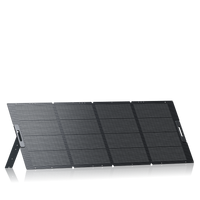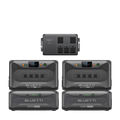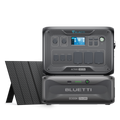Your cart is empty
Shop our productsThe importance of energy efficiency is quickly growing in the state of Iowa. It is no secret that electricity bills can be high, especially during the summer months when air conditioning demands are at their highest. But there are ways to reduce your electricity bill and save money in the long run. In this article, we will provide you with tips and tricks for how to save on your Iowa electric bill. We will cover everything from ways to reduce energy consumption at home to taking advantage of budget billing and energy efficiency programs.
Overview of the average electric bill in Iowa
Electric bills in Iowa depend on several factors, such as how much electricity is used, the electricity rate, and the type of customer. For example, residential customers typically have different rates than commercial customers. According to the U.S. Energy Information Administration, the average monthly electric bill for residential customers in Iowa was $107.42 in 2017. This number changes annually, depending on the season and weather. On an annual basis, the average bill is $1,288.04.
To understand how electric bills are calculated, let's use an example. Let's say a residential customer in Iowa uses 600 kilowatt-hours (kWh) of electricity in one month. In this case, the customer would be charged $81.94 for the energy usage and $25.48 for the demand charge, for a total of $107.42. This example is based on an average residential customer's rate in Iowa in 2017.
The demand charge is based on the peak usage of electricity within a month, and it can vary significantly from month to month, depending on the customer's usage. To calculate the demand charge, the customer's highest usage during any 15-minute period within the month is multiplied by the demand rate. The rates are set by the utilities, and typically, the higher the demand, the higher the rate.
In addition to the energy usage and demand charge, the customer may be charged taxes, fees, and other charges. This can vary from customer to customer, depending on the type of service, the terms of the agreement, and the state or local taxes and fees. In Iowa, the sales tax for electricity is 6%. So the customer in the example will be charged $6.44 in taxes.
the customer's total electric bill for that month will be $113.86, which consists of the energy usage, demand charge, and taxes. The customer can save money by understanding their electricity usage and taking steps to reduce their energy consumption.

How have Iowa electricity bills changed since last year?
Iowa's electric bills have seen some changes over the past year. According to recent data from the U.S. Energy Information Administration, the average electricity rate for Iowa in 2020 was 10.58 cents per kilowatt hour, a 6.3 percent increase from 2019. The statewide average electric bill for 2020 was $109.17, up 6.6 percent from 2019.Depending on where you live, rates can vary widely. The highest electric bills in 2020 were in Cedar Rapids with an average of $115.33, while the lowest were in Des Moines and Dubuque with $96.20 and $91.02 respectively.
The rate for electricity in Iowa is regulated by the Iowa Utility Board (IUB). The IUB sets rates for each utility based on its cost of providing service and other factors. Rates are reviewed annually, and the IUB has approved rate increases for some utilities in 2020. For example, MidAmerican Energy raised its rates by 6.4 percent. Determining the best rate for you depends on many factors, including where you live and which utility you use.
Understanding your electric rates is key to saving money on your electric bills. To begin, you can visit your utility's website to view rate information. You may also want to talk to your local utility about other programs that can help you save money on your electric bill. Programs such as MidAmerican Energy's Energy Wise program allow customers to manage their electric use more effectively, and may be able to save money in the long run. Additionally, the state of Iowa offers incentives and rebates to help reduce electric bills.
By understanding how electric rates are set and taking advantage of programs and incentives, you can save money on your electric bills and be better informed about your utility costs.

Why is My Electric Bill so High in Iowa?
The main factors affecting electricity charges in Iowa are the usage of energy, the cost of the energy, the availability of energy, and the delivery of energy. The cost of energy depends on the fuels used to produce it, the technology used to generate it, and the costs involved in transporting it. The availability of energy depends on the sources used to generate it, the efficiency of those sources, and the number of customers that rely on the same energy sources. The delivery of energy involves the transmission and distribution of the energy from the source to the customers.
For Iowa households, high energy charges are mainly caused by their usage of energy. Energy consumption is affected by the size of the house, the appliances used, the type of lighting used, the amount of air conditioning used, and energy-saving habits. The availability of energy in Iowa is also a factor that affects electricity prices. Iowa has some of the lowest electricity prices in the nation due to its extensive network of electricity generation and transmission. However, this network is not without its drawbacks, as the cost of delivering energy can be relatively high due to the need to maintain the system.
Another factor that affects electricity prices in Iowa is the cost of energy. The cost of energy is affected by the fuels used to generate it, the technology used to generate it, and the costs associated with transporting it. Iowa has some of the lowest electricity prices in the country due to its abundance of energy sources, such as coal, natural gas, and wind. In addition, Iowa is a leader in energy efficiency, which reduces energy costs for consumers.
the cost of delivering energy to customers is also a factor in electricity prices. The cost of delivering energy to customers is affected by the quality of the transmission and distribution lines, the distance between the source and the customer, and the number of customers that rely on the same energy sources. These costs must be factored into the cost of electricity.
For consumers in Iowa, high electricity bills are typically caused by their usage of energy, the availability of energy, the cost of energy, and the cost of delivering energy. Understanding how each of these factors affects electricity prices can help consumers save money on their electric bills.
The cost of electricity varies from state to state, with Iowa ranking in the middle when it comes to cost per kWh. To get the most bang for your buck, it’s important to compare the cost of electricity in Iowa to other states. Here is a comparison of 10 states in the region:
Comparison of Electricity State
| States | Price per kWh | Rank |
|---|---|---|
| Iowa | $0.10839 | 18 |
| Minnesota | $0.12937 | 7 |
| North Dakota | $0.09676 | 29 |
| South Dakota | $0.08266 | 49 |
| Missouri | $0.09220 | 33 |
| Wisconsin | $0.12686 | 9 |
| Illinois | $0.09800 | 27 |
| Nebraska | $0.08723 | 45 |
| Kansas | $0.07223 | 50 |
| US Average | $0.12320 | - |
As you can see, Iowa is slightly more expensive than the average US cost per kWh. However, if you compare Iowa to other Midwestern states like Wisconsin, Illinois, and Minnesota, you can see that Iowa is much cheaper. It pays to compare and shop around. South Dakota has the lowest cost per kWh in the region, making it a great place to look for more cost savings on your electric bill.

Who provides electricity to Iowa?
Currently, there are several providers of electricity in Iowa. The five most important ones are: MidAmerican Energy, Alliant Energy, Interstate Power and Light (IPL), Ottumwa Public Utilities, and Cedar Falls Utilities.
MidAmerican EnergyMidAmerican Energy is the largest provider of electricity in Iowa. It was founded in 1995 and now serves more than 744,000 customers across the state. MidAmerican Energy offers a variety of plans designed to help customers save money and reduce their energy use. It also offers renewable energy options, such as wind and solar, as well as energy efficiency incentives.
Alliant EnergyAlliant Energy is the second largest provider of electricity in Iowa. It serves more than 505,000 customers across the state. Alliant Energy offers competitive rates and a variety of plans designed to help customers manage their energy costs. It also offers renewable energy options, such as wind and solar, and an energy efficiency incentive program.
Interstate Power and Light (IPL)Interstate Power and Light (IPL) is the third largest provider of electricity in Iowa. It was founded in 1935 and now serves more than 302,000 customers across the state. IPL offers competitive rates and a variety of plans designed to help customers manage their energy costs. It also offers renewable energy options, such as wind and solar, as well as energy efficiency incentives.
Ottumwa Public UtilitiesOttumwa Public Utilities is the fourth largest provider of electricity in Iowa. It was founded in 1945 and now serves more than 130,000 customers across the state. Ottumwa Public Utilities offers competitive rates and a variety of plans designed to help customers manage their energy costs. It also offers renewable energy options, such as wind and solar, and energy efficiency incentives.
Cedar Falls UtilitiesCedar Falls Utilities is the fifth largest provider of electricity in Iowa. It was founded in 1960 and now serves more than 119,000 customers across the state. Cedar Falls Utilities offers competitive rates and a variety of plans designed to help customers manage their energy costs. It also offers renewable energy options, such as wind and solar, as well as energy efficiency incentives.
Iowa residents can pay significantly less for their electricity bills by following a few basic tips and tricks. Paying less for electricity in Iowa is possible by following a few simple steps. Some of these steps include reducing energy use, switching to a different electricity provider, and investing in solar energy.
Reduce Energy Use
One of the best ways to save on your electricity bill is to reduce how much energy you use. Making small changes throughout your home to reduce energy use can add up over time and help you save money. Some simple ways to reduce your energy use include unplugging devices when not in use, using power strips for your electronics, turning off the lights when not in use, and setting your thermostat around 68 degrees in the winter and 78 degrees in the summer.
Switch to a Different Energy Provider
The energy provider you choose can have a large impact on your electricity bills. Different providers have different rates and benefits. You can research online or contact the providers in your area to compare prices and plans. Make sure to do your research and compare prices and benefits before signing up with a new provider.
Invest in Solar Energy
Investing in solar energy is an excellent way to reduce your electric bills. Solar energy is generated from the sun’s rays and has no emissions or cost. Solar energy also has a low-maintenance cost and can be installed easily. The cost of solar energy has decreased in recent years, so it is now more affordable than ever. Investing in solar energy can save you hundreds to thousands of dollars on your electricity bills over the years.
How Solar Helps You Save on Electric Bills
Solar energy can help you save money on your electricity bills in a few ways. First, it helps reduce your energy bill by providing clean, renewable energy to your home. Second, solar energy can provide price stability. This means that you don’t have to worry about sudden price hikes or rate increases. solar energy can help you save money in the long-term by allowing you to generate your own energy and lower your electricity bills over time.
Cost Comparison: Existing Electric Bill vs Solar
The following table compares the 10-year, 20-year, and 30-year cost of an existing electric bill to solar energy:
| Cost | Existing Electric Bill | Solar |
|---|---|---|
| 10 Years | $10,000 | $7,000 |
| 20 Years | $20,000 | $14,000 |
| 30 Years | $30,000 | $21,000 |
1. Does my energy provider offer discounted rates for using energy during off-peak hours?
Many energy providers offer discounted rates for using energy during off-peak hours. These discounts help customers save money on their monthly energy bills by using energy during times when it is less expensive to produce. Off-peak hours vary depending on the energy provider and area, but are typically between 9 p.m. and 7 a.m. During these times, the demand for electricity is usually lower, and therefore, energy providers are able to offer lower rates.
In order to take advantage of these discounted rates, customers must check their energy provider’s website or contact their local utility company. Generally, customers are required to sign up for a special rate plan in order to be eligible for the discounted rates. Once a customer signs up, they will be billed at the lower rate during off-peak hours.
By using energy during off-peak hours, customers can save significantly on their energy bills. Additionally, during peak hours, when energy prices are typically higher, customers can reduce their energy consumption, thereby reducing their overall energy costs. It is important to note that the savings can vary widely depending on the specific energy provider and area.
many energy providers offer discounted rates for using energy during off-peak hours. Customers should check with their local utility company to see if discounted rates are available, and determine if signing up for a special rate plan will help them save money on their energy bills.
2. Does my energy provider offer any energy-efficiency incentives?
Your energy provider may offer energy-efficiency incentives that can help you save money and conserve energy. These incentives can include things like rebates for energy-efficient appliances, energy efficiency audits, and more. To find out what incentives your energy provider offers, you should check their website or contact them directly. Many energy providers provide detailed information about their energy efficiency programs on their websites.
Additionally, you can use the U.S. Department of Energy’s Database of State Incentives for Renewables & Efficiency (DSIRE) to search for energy efficiency incentives in your area. This database can help you find out what incentives are available from your state, local, and utility providers.
Making energy-efficient upgrades in your home can help you save money on your energy bills and do your part to reduce your carbon footprint. Taking advantage of available energy-efficiency incentives can be a great way to reduce your costs and make your home more energy-efficient.
3. Are there any local or state incentives or programs available to help me reduce my energy bill?
Yes, there are a variety of local and state programs and incentives available to help reduce your energy bill. Many states offer tax incentives or rebates for energy efficiency improvements. Some states also offer loans, grants, and subsidies for energy efficiency projects. Additionally, many local utility companies offer energy efficiency programs that provide discounts for energy efficient products and services.
For example, the California Energy Commission offers tax deductions for energy efficient improvements, and the Georgia Energy Loan Program offers low-interest loans for specific energy efficiency projects. On the local level, the Duke Energy Progress Home Energy Savings program provides rebates for energy efficient products, and the San Antonio Public Utilities provides discounts for energy efficient appliances.
In addition to these programs, many states and cities offer energy audits that can help you identify areas in your home that can be improved to reduce your energy bill. An energy audit can help you identify areas where you can add insulation or increase the energy efficiency of your appliances.
By taking advantage of local and state programs and incentives, you can reduce your energy bill and become more energy efficient.
4. What type of energy-saving tips are available from my energy provider?
Your energy provider should be able to provide you with a range of energy-saving tips that can help you reduce your energy consumption and save money on your energy bills. Here are some of the tips that you should look for:
Unplug Electronics and Appliances When Not In Use: Unplugging electronic devices and appliances when not in use is an easy way to reduce your energy consumption. This will help to reduce the amount of energy being used even when the devices or appliances are not being used.Install Energy Efficient Appliances: Energy efficient appliances use less energy than standard appliances. When purchasing new appliances, look for ones that are Energy Star qualified to get maximum energy-savings.
Reduce Water Wasting: Taking shorter showers and turning the water off when brushing your teeth can help reduce water waste. Installing water-saving shower heads will also help reduce your water consumption and save energy in the process.
Invest in Insulation: Investing in insulation will help regulate your home’s temperature and reduce the need for air conditioning and heating. This will help you save energy and lower your energy bills.
Switch to LED Lightbulbs: LED lightbulbs use significantly less energy than standard lightbulbs, and last significantly longer. This is a great way to reduce your energy consumption and save money.
Utilize Natural Light: Taking full advantage of natural lighting during the day can help to reduce the amount of energy being used for lighting. This is an easy way to reduce your energy usage and save money.
5. What types of energy-saving appliances are available and how much can they save on my electricity bill?
Energy-saving appliances are an excellent way to reduce energy consumption and save money on your electricity bill. There are a variety of energy-saving appliances available, from refrigerators and washing machines to dishwashers and air conditioners. Many of these appliances come with Energy Star ratings, which can help you determine which appliances are most efficient.
Refrigerators are one of the most energy-intensive appliances in the home, and choosing an Energy Star model can help you reduce your energy usage and save money on your electricity bill. Many modern refrigerators feature energy-saving settings that can help to limit the amount of energy used and increase the efficiency of the unit. Smart refrigerators are also available that can track the energy usage and alert you when it’s time to make adjustments or schedule maintenance.
Washing machines have also become more energy-efficient in recent years. Energy Star models are designed to reduce energy usage and operate at lower temperatures, which can save money on water bills as well. Air conditioners are another big energy-user and buying an Energy Star model can reduce energy usage by as much as 50%.
Dishwashers are also becoming more energy-efficient, with many Energy Star models now available that can save you up to 35% in energy costs. Smart dishwashers are also available that can alert you when it’s time to adjust the settings to reduce energy consumption.
By investing in energy-saving appliances, you can drastically reduce your energy usage and save money on your electricity bill. With the wide variety of Energy Star models available, you can find the perfect appliance to fit your needs and budget.
Ultimately, reducing your electric bill in Iowa is a matter of making informed decisions regarding your energy consumption. By utilizing the tips and tricks outlined above, you'll be on your way to lower electric bills and a greener future. Remember to research your options, be aware of what your energy consumption entails, and make small changes to your lifestyle that will have a big impact on your electric bill. With a little bit of effort, you can easily save money on your Iowa electric bill.
Shop products from this article
Be the First to Know
You May Also Like

How to Pay Your Duke Energy Bill: A Comprehensive Guide

How Many Amps Does an Electric Water Heater Use? (2025)

Best Camping Games to Make Your Adventure Unforgettable
Camping happens to be the only way one can relax in nature and catch up with buddies and family while indulging in some of the most memorable activities. Besides stories...






































































































































































































































